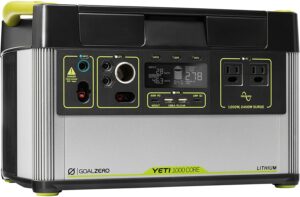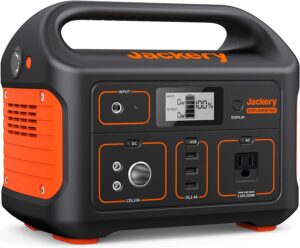
Power Station
A battery power station is a power station that uses batteries to store energy and generate electricity. Battery power stations are usually used as backup power sources or for off-grid applications, emergency backup and for travel.
What is a Battery Power Station?
A battery power station is, quite simply, a power station that runs on batteries.
Battery powered stations work by storing energy in batteries and then using that stored energy to generate electricity. This electricity can then be used to power phones, tablets, computers and even entire homes and businesses.
One of the main benefits of battery powered stations is that they are extremely versatile. They can be used in a variety of different settings and can be customized to meet the specific needs. You can find units suited for travel and hiking, having in your car or placed in your house or business as a backup for power outages.
Another benefit of battery powered stations is that they are environmentally-friendly. Unlike traditional diesel or petrol generators that run on fossil fuels, battery powered stations do not produce any harmful emissions or pollutants. This makes them a much more sustainable and eco-friendly option for generating electricity.
Portable power stations

One of the key benefits of portable power stations is that they are able to charge multiple devices at once. This makes them ideal for both personal use and group situations, such as camping trips or outdoor events where multiple people need to keep their devices charged.
Another advantage of portable power stations is that they can be used as a backup power source in case of an emergency. This can be particularly useful for individuals who live in areas prone to hurricanes, tornadoes, or other natural disasters. Portable power stations can provide a much-needed source of power when traditional grid-based power sources are unavailable.
The smaller ones is a convenient, lightweight solution for powering small devices, such as smartphones and laptops, on the go. These handheld power stations are typically compact and lightweight, making them easy to carry in a backpack or travel bag. They may also come with built-in AC outlets for directly plugging in devices that require large amounts of power, such as desktop computers and refrigerators.
Some examples of portable power stations:
Portable power stations are generally very easy to use, with most models featuring simple, user-friendly controls. This makes them an ideal option for individuals who are not familiar with more complex power management systems.

Choosing the Right Portable Power Station
When choosing a portable power station, there are several factors that you should consider. These include the capacity of the power station, its durability and resilience to damage or wear and tear, and its ease of use.
One important consideration when choosing a portable power station is its capacity. This refers to how much power the power station can provide at one time. If you are planning on using the power station to charge multiple devices at once, or to power larger devices such as laptops or desktop computers, you will need a power station with a higher capacity. On the other hand, if you only need to charge small devices such as smartphones or tablets, a lower-capacity power station may be sufficient.
Another important factor to consider when choosing a portable power station is its durability and resilience to damage or wear and tear. This may include looking for models that are designed with sturdy, durable materials, or that come with features such as built-in AC outlets or USB ports that help protect against exposure to moisture or heat.
Finally, when choosing a portable power station, it is important to consider its ease of use. This may include looking for models that feature simple and intuitive controls, as well as a clear display that allows you to easily monitor your power usage and make any necessary adjustments. Additionally, if you plan on using the power station in group or emergency situations, it may be helpful to look for models that can be easily shared or passed around.
Ultimately, when choosing a portable power station, it is important to consider your specific needs and evaluate different models based on these factors. By taking the time to carefully evaluate your options and choose a high-quality power station that meets your needs, you can be sure to get the most value from this versatile and convenient device.
Conclusion
A portable power station is a convenient and versatile device that allows you to easily access electricity anywhere, anytime. There are many factors to consider when choosing a portable power station, including its capacity, durability, and ease of use. Some important considerations may include the size or weight of the power station, the quality or materials used in its construction, and the user-friendliness of its controls and display. Ultimately, by taking the time to evaluate these factors and choose a high-quality power station that meets your specific needs, you can be sure to get the most value from this useful device.